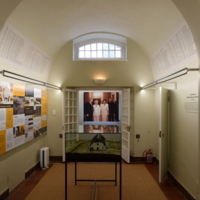
Swellendam Drostdy Museum
Swellendam Drostdy Museum is one of 28 museums affiliated with the Western Cape Provincial Government's Museum Service. The museum is located in the former court complex in Swellendam, built in 1747 when Swellendam was situated on the frontier of the Dutch Cape of Good Hope. It was founded in 1939 and its displays are somewhat dated and offer a Eurocentric interpretation of the past. The collective heritage of Swellendam is represented through a magistrate's chamber, court room, and a number of domestic settings where the landdrost and his family would have relaxed between the important duties of enforcing European jurisdiction. A safe, the only original item from the building not destroyed in an 1865 fire, occupies a prominent place as a tangible link to this past.
A display opened in one of the barn outbuildings in 2006 seeking to imagine what this outbuilding may have been like two hundred years previously when it may have functioned as slave quarters. The Drostdy Museum's display illuminates a possible surviving link, doing this through a number of straw sleeping mats, food props, and carts. A series of interpretation panels explain slavery at the Cape and give the names and roles of several people enslaved/indentured at Swellendam Drostdy. In light of this, it is somewhat problematic that the museum created controversy in 2015 when it leased one of its buildings to an upmarket eatery. This was given the name 'The Whipping Post' by its owner in reference to the whipping post which formerly stood adjacent to the jail. Activists and local politicians highlighted the links between slavery and the original whipping post, and the outlet was ultimately renamed 'The Trading Post'.

Vergelegen
Vergelegen is a wine estate, founded in 1700 and presently owned by Anglo-American subsidy AmFarms. As with the majority of South African wine farms of such a vintage, its early labour force rested on enslavement. Historical interpretation on the estate can be traced to an archaeological dig conducted by a team of academics from the University of Cape Town between 1990 and 1992. At a time of burgeoning scholarly enquiry into Cape slavery, this work excavated the former slave lodge on Vergelgen with the explicit intention of unearthing items which might hint towards the existence of slave culture. A number of personal items including coins and buttons were discovered, whilst the most significant find was of the skeletal remains of an enslaved woman who was affectionately named ‘Flora’ by estate staff.
The results of the archaeological work were displayed in the estate’s foyer together with contextual information. This made Vergelegen probably the first location in South Africa to mount a detailed exhibition relating to Cape slavery. The existence of the archaeological objects can be considered particularly significant, given that few tangible links with Cape slavery exist in museum collections. A second exhibition focussing on Vergelegen’s historical owners was developed several years later in the former manor house, and both exhibitions were subsequently amalgamated prior to being refreshed in 2016.
Presently, the names of people known to have been enslaved on Vergelegen are listed on the wall/ceiling of the first gallery, whilst the origins of enslaved people and their role on the estate are made clear. The objects unearthed during the early 1990s are displayed as tangible links with a past described by text. Additional historical context focuses on wine farming and the early Cape economy, historical estate owners, and notable visitors to Vergelegen.